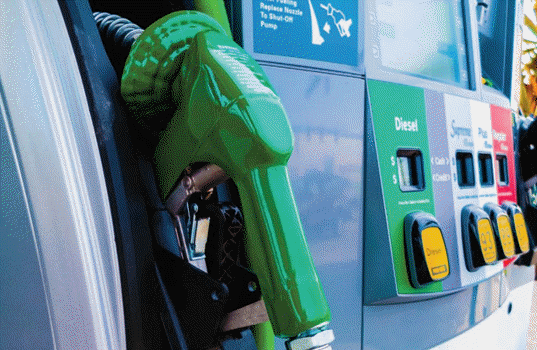Diesel Quality and Production
Improving diesel fuel quality has been a quest lasting over three decades, and it continues to this day. In the U.S., the California Air Resources Board (CARB) led the way in 1988 with the “Proposed Adoption of Regulations Limiting the Sulfur Content and the Aromatic Hydrocarbon Content of Motor Vehicle Diesel Fuel.” CARB had been the first major regulatory agency to link aromatics with emissions, though other international agencies were discovering that emissions were reduced when using diesels with high cetane numbers and high percentages of paraffinic compounds.
At the national level, the U.S. Environmental Protection Agency (EPA) began regulating the maximum allowable sulfur level in 1993. Prior to this, diesel fuel legally could contain as much as 5,000 parts per million (ppm,) or the astonishing amount of 0.5% sulfur by weight. In many cases, thankfully, this constraint was not binding, and actual sulfur levels were considerably lower depending on the refinery feedstock and technological capability. The maximum standard of 500-ppm sulfur (0.05%) then was adopted. This quickly became considered an interim measure, because discussions were underway to move to ultra-low sulfur diesel (ULSD) with a maximum sulfur content of 15 ppm. Indeed, U.S. diesel sulfur standards were lagging the ones adopted in other countries. For example, Japan adopted a 50-ppm sulfur maximum standard in 2005. This standard caused no disruption to supply, because Japanese refiners already in 2003 had voluntarily moved to 30-ppm sulfur diesel. Japan then adopted a 10-ppm sulfur standard effective in 2007, and once again Japanese refiners came in early and made 10-ppm sulfur diesel available beginning in January 2005. Countries in the European Community also were moving quickly toward ULSD with the Euro standards.
Since 2006, the great majority of on-road diesel in the U.S. became 15-ppm sulfur maximum ULSD. The 15-ppm maximum standard spread to all diesel uses except for marine fuel between 2010 and 2014. Adopting and implementing diesel quality standards was a lengthy and complicated process, with rules varying by submarket, type of diesel, season and size of refiner or importer. The effort has been considered a success, however. The EPA calculates that the diesel fuel standards reduce harmful emissions by over 90%.
As the year 2020 begins, many analysts are watching diesel markets to discern whether the adoption of IMO 2020 (International Maritime Organization) 500-ppm sulfur marine fuel will cause supply or price disruptions. Marine fuels had been one of the few places where refiners could blend high-sulfur streams, and it was feared that eliminating this outlet could cause low-sulfur diesel prices to spike above high-sulfur grades. While it is still early in the year, supplies of complying fuel have been available, and the prices have not spiked. In the U.S., desulfurization capability has expanded enormously.
Increasing the yield of high-quality diesel required billions of dollars of capital investment in U.S. refineries over several decades. Figure 7 examines hydrocracking and hydrotreating as two key indicators of diesel production capability. These are indexed against crude oil refining capacity in order to see how their relative roles have grown. (That is, if hydrocracking and hydrotreating capacity doubled, but crude refining tripled, diesel yield and quality might not improve in relative terms). Hydrocracking is the chief upgrading technology that is used to maximize low-sulfur, high-cetane diesel blendstocks. In 1987, U.S. crude oil distillation unit (CDU) capacity was 14.915 mmbpd, while hydrocracking (HDC) capacity was 1.07 mmbpd, giving a ratio of 7% HDC to CDU. Hydrocracking is an expensive technology, but U.S. refiners more than doubled their HDC capacity to 2.285 mmbpd in 2019, ending up with a ratio of 12% HDC to CDU.
Middle distillate hydrotreating (HDT) capacity also was added aggressively during those years. In 1987, middle distillate HDT capacity was 2.567 mmbpd, giving a ratio of 17% HDT to CDU. By the year 2019, HDT capacity had grown to 6.648 mmbpd, more than doubling the ratio to 36% HDT to CDU. Note that the types of hydrotreating units included in this reckoning are the ones dedicated to middle distillates only. Other types of hydrotreating capacity were built to remove sulfur from heavy gas oils going to cracking units, naphthas going to catalytic reforming units, and naphthas from catalytic cracking units destined for gasoline blending.
The additions to HDC and middle distillate HDT allowed the U.S. to produce larger volumes of higher-quality diesel. Figure 8 shows the progress in phasing out high-sulfur diesel. In 1993, U.S. refineries produced 2.234 mmbpd of diesel with sulfur contents of over 500 ppm and 0.898 mmbpd of diesel with sulfur contents between 15 ppm and 500 ppm. The amount of high sulfur diesel produced was cut by more than half as it was phased out in favor of diesels with 15 – 500 ppm sulfur during the decade between 1995 and 2005. In 2005, 2.909 mmbpd of diesel in the 15 – 500 ppm sulfur range was produced. After this, the high-sulfur grades quickly began to dwindle. Medium-sulfur grades also were shifted to ultra-low sulfur levels. Refiners began to produce ultra-low sulfur diesel of 15-ppm sulfur and below in 2004, when U.S. refinery production was reported at 20,000 bpd. ULSD production began to rise, though the chart shows a brief downturn of all grades produced in 2009 during the Great Recession. During the first three quarters of 2019, ULSD production averaged 4.816 mmbpd. Output of medium-sulfur grades has dwindled to a mere 0.127 mmbpd, while production of diesel containing over 500 ppm sulfur averaged just 0.202 mmbpd.
Adoption of biodiesel and biodiesel blends has expanded supply also. The EIA reports that U.S. biodiesel production averaged 104,110 bpd in 2017, 121,135 bpd in 2018, and 114,818 bpd during the January – October period of 2019. This has brought its own set of quality issues, centering mainly around the various forms of water contamination. Certain microbes, often called the “diesel bug,” can thrive in environments where both diesel and water are present. While these microbes can grow in petroleum-based diesel as well, biodiesels made from plant and animal fats offer a more attractive food. They also are more likely to attract water.










